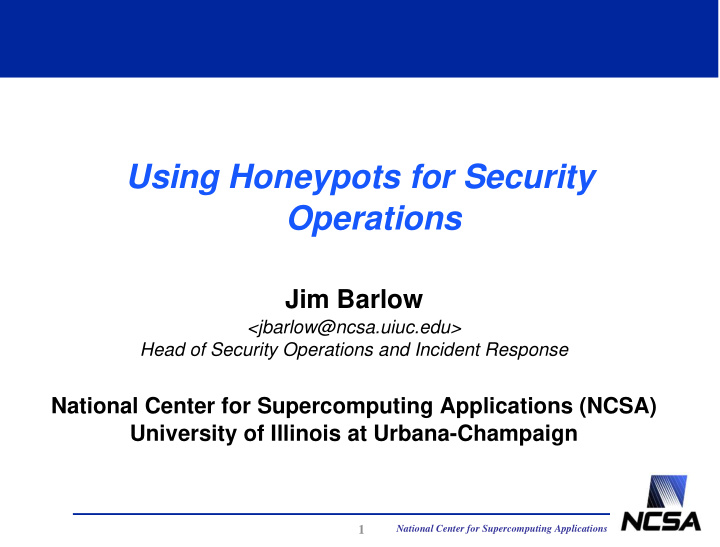



Using Honeypots for Security Operations Jim Barlow <jbarlow@ncsa.uiuc.edu> Head of Security Operations and Incident Response National Center for Supercomputing Applications (NCSA) University of Illinois at Urbana-Champaign National Center for Supercomputing Applications 1
Outline ● Honeypots and why did we start using them? ● Details on incident involved with ● Setting one up and honeypot activity ● What we learned ● Other areas of application ● Future work National Center for Supercomputing Applications 2
Traditional Honeypots ● First used for researching blackhat activity ● Set up a honeypot, see who breaks in ● Know your enemy papers National Center for Supercomputing Applications 3
Why did we set one up? ● Had incident where we wanted to get specific intruder on our honeypot to monitor ● Persistent intruder ● Generally intruders move to greener pastures when discovered National Center for Supercomputing Applications 4
What did we want to find? ● Where are they coming from? ● Where are they going? ● What tools are they using? ● What exploits are being used? ● Motive? National Center for Supercomputing Applications 5
More details on incident ● Miscreants were using trojaned ssh clients to compromise accounts ● Would then attempt local exploits ● Large number of compromised accounts and machines ● Tended to use same system to launch attacks for days or weeks ● Can we get them to use our system? National Center for Supercomputing Applications 6
Setting up honeypot ● If we build it, will he come? ● Can be a hard problem, how to get specific intruder onto our honeypot? ● Bait and Switch honeypots ● http://baitnswitch.sourceforge.net/ ● US DoD – Net Force Maneuver ● We decided to use Sebek from honeynet.org ● Used their own tool against themselves ● Use trojaned ssh client to log into honeypot National Center for Supercomputing Applications 7
First honeypot activity ● Fed account into their “collector” using tojaned ssh client (on compromised machine). ● Intruders logged into our honeypot within 2 minutes ● There were no local vulnerabilities on honeypot ● Session 1 output National Center for Supercomputing Applications 8
What did this tell us? ● Actively using and monitoring passwords collected ● Specific commands they used ● Some of what they initially look for ● ssh host sh -i ● IP address attacking from National Center for Supercomputing Applications 9
Honeypot round 2 ● Second account fed took three hours to log into system ● Session 2 output ● Different command syntax ● Does that tell us anything? ● Few more hits over next couple days National Center for Supercomputing Applications 10
Additional hits on second hp ● Spent more time on system around a week later ● Some interesting information ● Looking for exported filesystems ● Targeting our teragrid cluster ● Download and use of nfsshell tool ● Session 3 output National Center for Supercomputing Applications 11
Third times a charm? ● Fed account on third honeypot system ● Knew format of password collector and could feed accounts at random ● Compromised machine on our network using scan and sploit. ● We were able to see everything they did on the compromised system. ● Lots of interesting items discovered ● Session 4 output National Center for Supercomputing Applications 12
Other interesting sessions ● Started giving them boxes that could be rooted ● Would they start using the machine more? ● After getting root ● Didn't install standard rootkit ● Installed mod_rootme package ● Started web server as root ● OpenSSL led to additional compromise National Center for Supercomputing Applications 13
How did this all help us? ● Categorize vulnerabilities being exploited ● Identify IP address attacking from ● Get tools being used ● How and where they were getting them from ● ie. uuencoding – thought safe ● Share all this with trusted community ● Also created “info file” that could be shared with newly affected sites National Center for Supercomputing Applications 14
What else did this tell us about the miscreant? ● Strange habit of logging in, out, and back in again ● Why? More than one person? ● Once on machine logs onto localhost ● Changes last login entry ● Seems all attacks were done manually ● Occasional special characters typed ● Foreign character set? ● Maybe possible to analyze commands to determine if more than one person ● Eventually hp not needed (at times) National Center for Supercomputing Applications 15
Attack network Inside U.S. Compromised hosts Route in Password collector Outside U.S. Web server National Center for Supercomputing Applications 16
Other areas we are using honeypots ● SSH brute force logger ● Logging usernames and passwords for last 9 mo. ● Create account with one of these common ones and watch what they do ● Wash/rinse/repeat ● Categorize attackers? ● X server honeypot ● Remote site with similar name ● ncsa.teragrid.org vs. ncsa.org National Center for Supercomputing Applications 17
Other uses of honeypots/honeytokens ● Honeytokens/web bugs ● Bugged email ● Web page/email archive ● How long till it's mined off of google? ● Online forensics from honeypot ● Needed to access remote machine ● Log in from ssh password collector ● Thought compromised host was blocked at border National Center for Supercomputing Applications 18
Future Work ● Distributed honeynet ● Same username at multiple sites (known_hosts attack) National Center for Supercomputing Applications 19
Questions? Gracias jbarlow@ncsa.uiuc.edu National Center for Supercomputing Applications 20
Recommend
More recommend